All the joy of tasty bramble jam but with none of the pesky seeds! This easy Seedless Blackberry Jam recipe includes full step by step instructions to make a small batch of preserves. The versatile recipe can easily be scaled up or even mixed with other berries so there is no excuse not to try it!

This post may contain affiliate links. Please refer to my Disclosures Page for more details.
I’m continuing my mission to conquer the world with my seedless jam recipes.
Of all the recipes I’ve published so far, I think blackberry jam is really the one that needs the seeds removing the most. Even folk that aren’t normally bothered by berry and fruit seeds can find blackberry seeds a bit overwhelming.
Either way, the silky smoothness of this jam makes it a pleasure to eat and the taste is obviously amazing. There is something even more delicious about brambles/blackberries when you grow or forage them yourself.
Smooth & Seedless Jam Recipes
Here you’ll find all of my fabulous jam recipes in one easy place. With no pesky pips, my recipes are all written to make small batches but can easily be scaled up to make larger quantities.
Featuring mixed berry, plum, blueberry, blackberry, strawberry, and raspberry, fig and dark cherry jams plus some ideas how to use it.
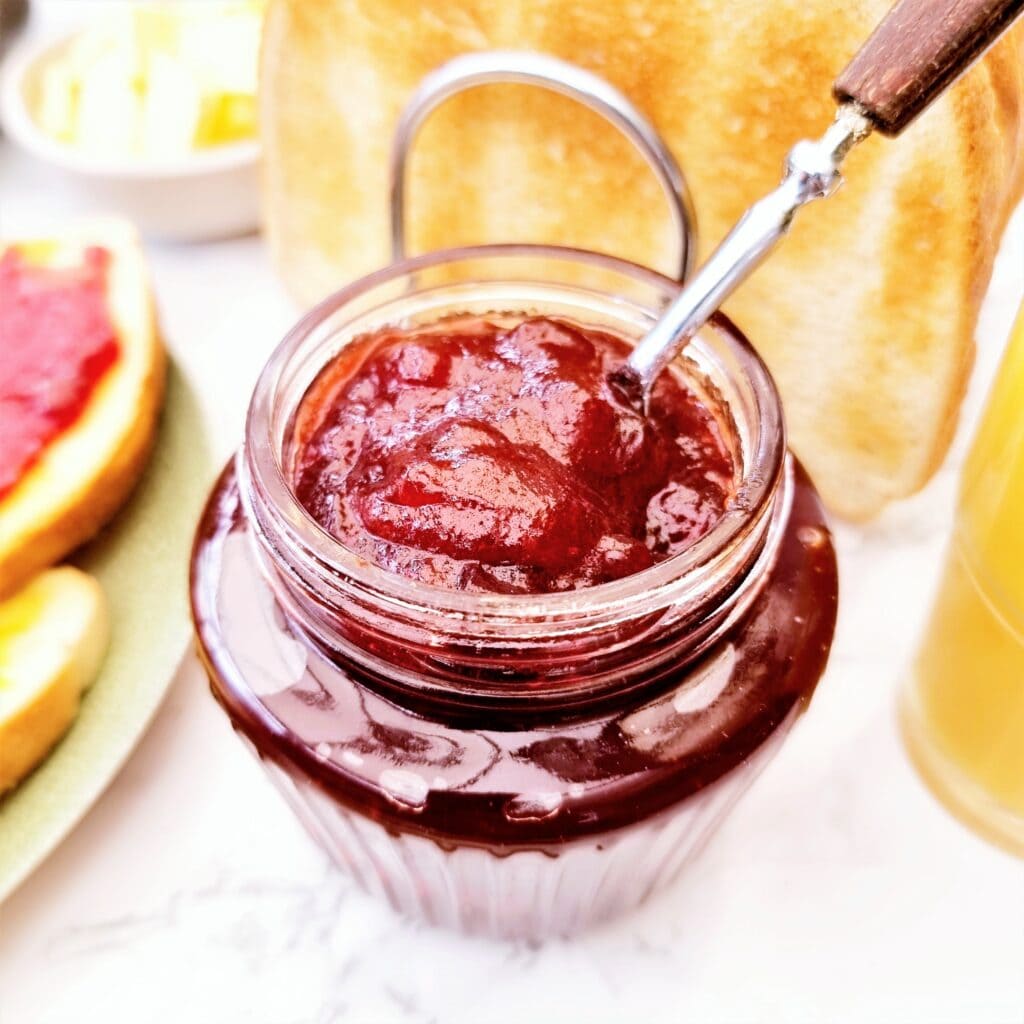
- Smooth & Seedless Jam Recipes
- Is There a Difference Between Blackberries and Brambles?
- How to Serve Blackberry Jam
- Seedless Blackberry Jam Ingredients
- Equipment Notes for Homemade Bramble Jam
- Get Ahead
- How to Sterilise Jars and Preserve/Can Jam
- Easy Blackberry Jam Recipe Tips
- Still Have Questions?
- Keep Up to Date
- More Blackberry Recipes
- The Recipe
- Full Step-By-Step Recipe

Is There a Difference Between Blackberries and Brambles?
Not really, especially in eating, cooking or baking terms. Bramble is simply the name given to blackberries which grow in the wild. In the US, the term caneberry might be more common than bramble.
The technical answer is slightly more complicated. The term “bramble” actually refers to a whole group of wild growing berries. This can also include raspberries and a similar looking fruit called dewberries.
Especially here in the UK, you can absolutely use the terms and fruit totally interchangeable.
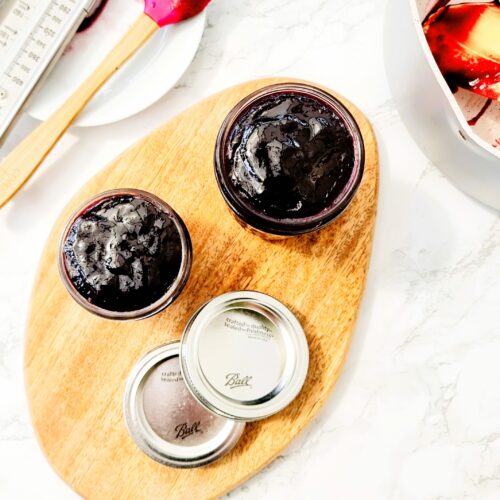
How to Serve Blackberry Jam
I always advise that you should try to serve jam at room temperature. This will give you the best flavour and texture. Any open jars really should be kept in the fridge so you may need to be a little organised when it comes to getting it out 20 minutes or so before you want to eat.
As for what to serve blackberry jam with, there are a myriad of options.
The most classic and British way would be to add it to any warm split scone along with lashings of butter and clotted cream. Even more traditional would be to make jam sandwiches with buttered white bread, spread it on toast for breakfast or top scotch pancakes for a teatime treat.
I love to use darker berry jams in my victoria sandwich cakes for a more autumnal feel and I happily use any of my jam recipes in my microwave jam sponge pudding.
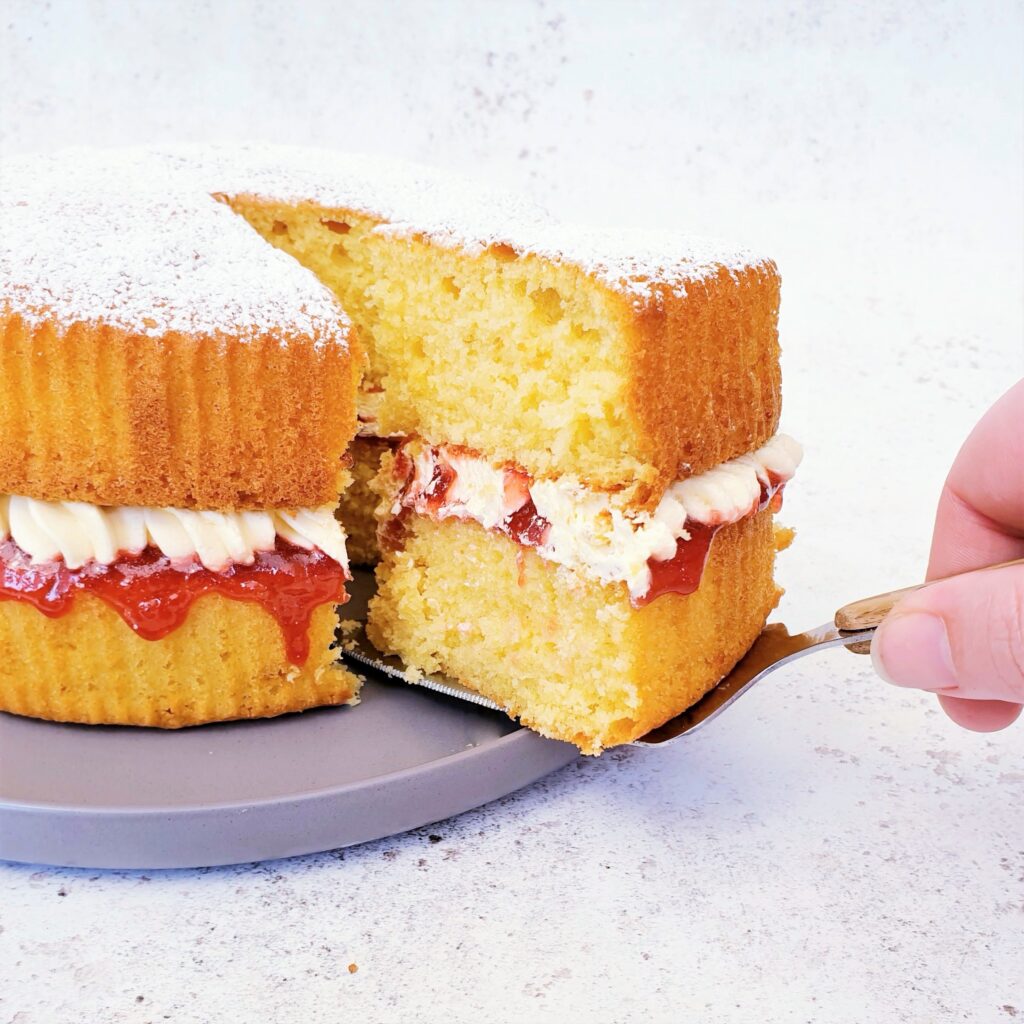
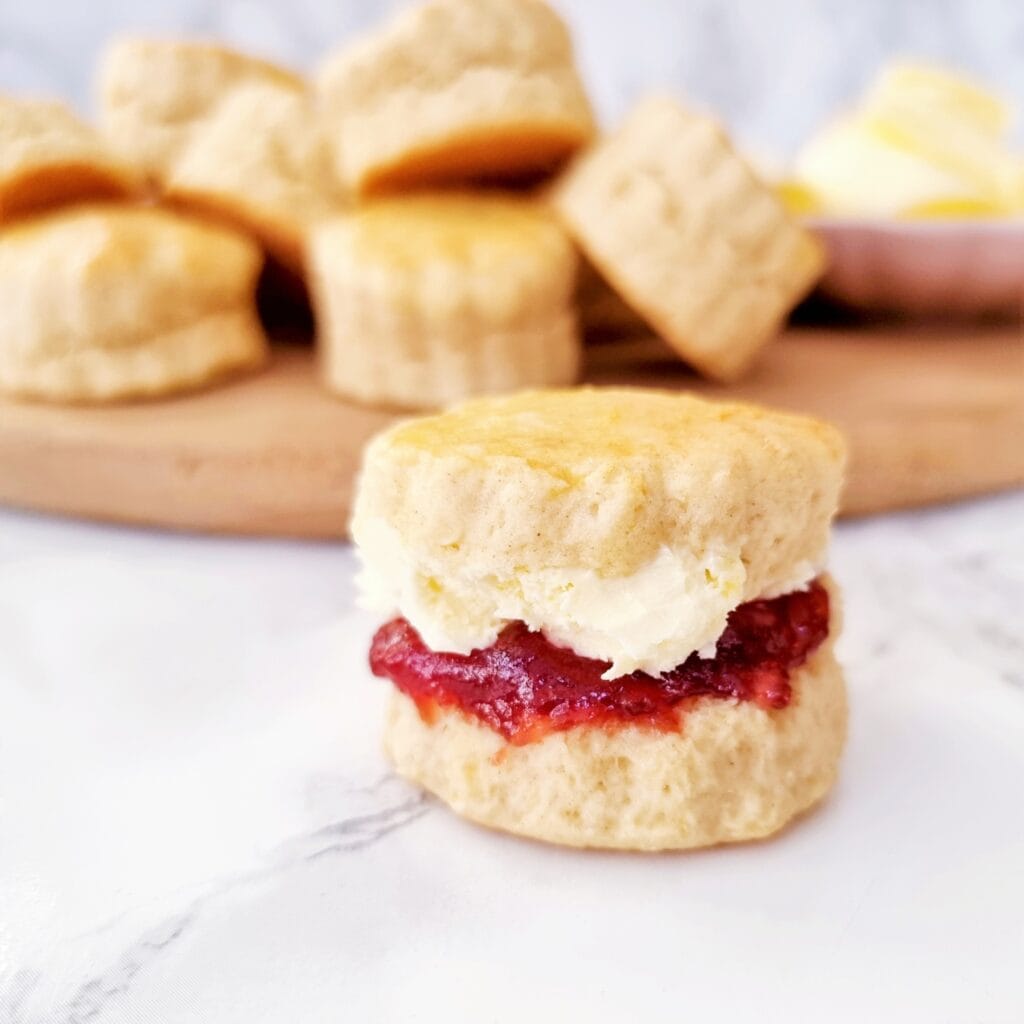
Seedless Blackberry Jam Ingredients
Blackberries
Any shop bought, home grown or wild foraged blackberries/brambles are going to work for this recipe.
Just make sure that you’ve gone through them and removed any little pieces of stalk etc. For the most part any rogue bits will get sieved out but I prefer not to take the chance.
As the berries get cooked down before being blended and sieved, you can include any under or overripe berries. But exercise caution if including too many very under-ripe ones as they tend to be a bit lacking in flavour.
Sugar
To make jam, all you need is regular white sugar. There is no need for expensive specialist jam sugar that contains added pectin, which isn’t necessary for this recipe. Blackberries naturally contain a good amount of pectin.
It’s actually irrelevant whether you use regular or caster/superfine sugar since it will melt in the pan. I personally opt for granulated sugar as it is a more economical choice. Save the pricier caster sugar for when it’s more essential.
Avoid the temptation to use brown sugar or sugar alternatives as they will impart an unusual flavour or texture to the jam, respectively.

Lemon Juice
Adding lemon juice to jam recipes adds both a little extra pectin and some freshness and acidity which cuts through the sweetness.
You can use fresh lemon juice if you wish but I generally just use bottled lemon juice in this sort of recipe. It is convenient, economical and results in zero waste.
As the amount of lemon juice added does affect the set of the jam, if you want to add more lemon flavour, it is better to add some zest as the blackberries are cooking down rather than more juice.
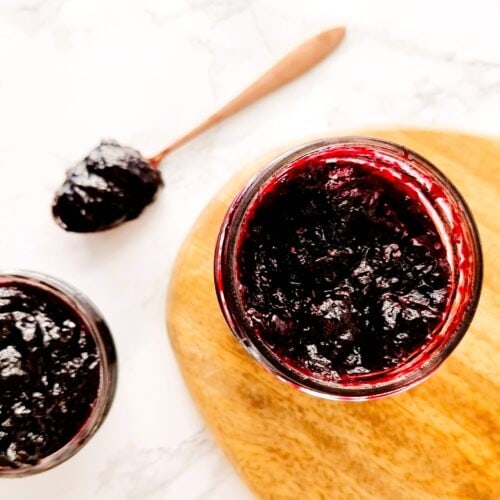
Be Flexible
Jam is ultimately a very flexible thing to make. You can combine the blackberries with nearly any other fruit you want. But do obviously consider the resulting flavour. I would generally tend to stick with other berries or even cherries.
You can add other flavourings by way of citrus zest – orange works very well with blackberry flavour. You can also add spices. Warming winter spices are quite common to pair with blackberry but go easy as the flavour could easily be overwhelmed by something like cinnamon or star anise.
Alcohol is a great addition. Adding gin to anything is super fashionable but I love to add a rich and smoky whisky or bourbon to blackberries. A spiced rum is also good. You could add flavoured liqueurs such as orange triple sec/Cointreau, almondy amaretto or even coconut rum.
Please don’t try to use less sugar as this is what preserves the fruit and provides some of the body of the jam.

Vegetarian or Vegan Blackberry Jam
This blackberry jam recipe is suitable for both vegetarians and vegans as written.
Make Allergy Friendly Smooth Blackberry Jam
This recipe is free from egg, dairy, gluten and nuts.
Please note that this recipe may contain other allergens not referred to above and any variations suggested have not been tested unless otherwise stated. For more information regarding any dietary information provided on this website, please refer to my Nutritional Disclaimer.
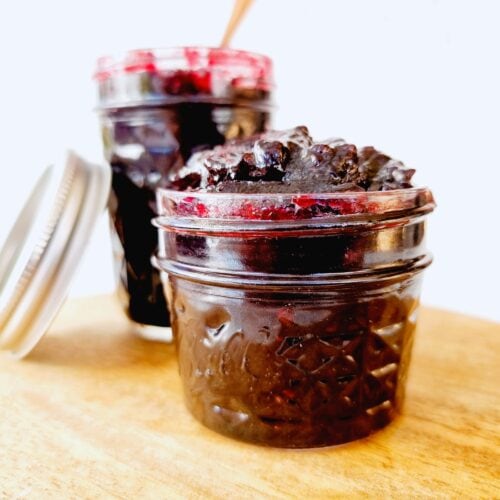
Equipment Notes for Homemade Bramble Jam
Jam doesn’t require any specialist equipment. The most important thing is to have a good sized pan. This recipe using just over a pound of fruit (600g) makes a fairly small amount of the finished product but you still need to use a good large saucepan.
You might think that I’m being excessive when you first see the amount of fruit in the pan but it bubbles up so much when boiling, you’ll soon understand why.
There are a few things that will help make your jam making easier although they’re not essential. A thermometer is one of them. It turns out that I own quite a selection and they are all suitable. My laser thermometer (centre) is mess free and fun to use.
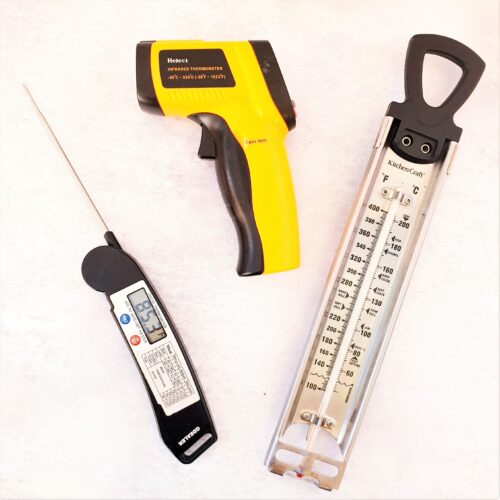
My meat thermometer (left) posed a little more peril as I needed to hold it in the jam until it registered the temperature. And my old fashioned sugar thermometer (right) just happily sat in the pan the whole time. But it was harder to wash up!
And don’t forget something the store the jam in. I love my super cute quilted jam jar set. But you can simply use old jam jars that you’ve thoroughly cleaned.
A comprehensive list of the equipment used to make this recipe is included in the main recipe card below. Click on any item to see an example. There are no hard and fast rules so many items can be sensibly substituted to achieve the same results.

Get Ahead
You must get ahead when making jam! Ideally you need to be making it at least 24 hours before you want to eat it. You can speed up the cooling process by putting the jars in the fridge once they’re cooled for a couple of hours.
Jam, if stored in sterilised jars, will last at least a year. It doesn’t need to be refrigerated unless the jar is open but it does need to be in a cool place.

How to Sterilise Jars and Preserve/Can Jam
There is a whole world of variations and advice for how you should prepare your jars and deal with the jars once they’re sealed. They vary from person to person and country to country.
Here in the UK we largely make sure that the jars are properly sterilised, fill the jars with the hot jam, seal them and that’s that. In the US it is almost a given that the jars will then be “processed” to complete the “canning” process. I have purposely provided no links here – if you’d like to learn more about canning, Google is your friend.
There are a lot of strong feelings about this in the “jam community” (yes there is one) which I have no interest in being drawn into. All I know is that UK cooks have been making jam for a very long time without any issues. Therefore I am more than happy to follow the UK process for my jams.
Jar Sterilisation Options
There are several ways that you can sterilise your jam jars.
- Run the jars and lids through a hot wash in the dishwasher.
- Bake the jars and lids in the oven on a baking tray.
- Microwave the jars and boil the lids in water.
- Boil the jars and lids in water.
Whichever method you choose the only important thing is to make sure that the jars and lids are left to dry without being touched. And that you do not under any circumstances touch the inside of the jars or lids as this can contaminate them and undo your sterilisation. Tongs are your friend.
For the record, I usually use the dishwasher method.
How to Tell if the Jar is Sealed
It is essential to add the lid to the hot jars filled with the hot jam straight away. As the jam and jar cool, a vacuum is created in the jar and the lid will be pulled downwards. To help this, I often turn my jars upside down to cool.
This means that when you press the lid, it doesn’t move or pop. When you open a jar of properly sealed jam the lid will then pop. And an opened or not properly sealed jar will pop when you press it.
If your jars don’t seal properly, you can either keep the jar in the fridge and eat it relatively quickly or go though a canning process to seal them. The choice is yours.
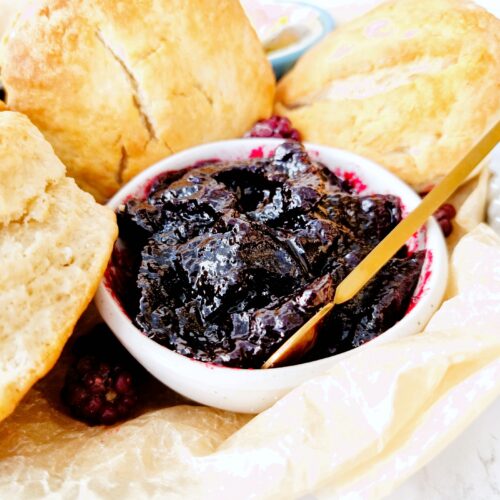
Easy Blackberry Jam Recipe Tips
Do not touch the hot jam. I cannot stress this enough. I don’t care how tempting it looks. Or if that little bit on the side looks a bit cooler. Do. Not. Touch. It. You will regret it.
I mentioned before to use a good big saucepan. This is worth repeating here!
If you are using a thermometer, you can simply rely on the jam hitting temperature and not worry about doing the wrinkle test on a cold plate. I like to take a belt and braces approach so I use both testing methods. But you can just use one or the other.
If you aren’t bothered about the jam being seedless, skip the blending and sieving stage but give the fruit a good mash down with the spatula while it starts cooking.
If you don’t need to keep your jam for any length of time, you can skip the jar stage and use any old container and keep your jam in the fridge.

Don’t forget to let me know in the comments if you try making this recipe – I want to know what you think and if you made any substitutions, how did it turn out?
Still Have Questions?
Simple! Just contact me and I will do my best to help as quickly as I am able. Head over to my Contact Me page, any of my social media channels or post a comment at the bottom of this page and I’ll see what I can do.
Pin Seedless Blackberry Jam For Later
Hit one of the share buttons to save this page to your Pinterest boards so you can come back and find it at anytime!

Keep Up to Date
Make sure you SUBSCRIBE to my newsletter and avoid missing out on any of my newest and bonus content. Don’t worry, I promise not to spam you or bombard you too often. Plus you’ll receive a copy of my FREE 7 Day International Meal Plan!
Also please don’t forget to follow me over on my social media channels over at Facebook, Twitter, Instagram and Pinterest. I love to interact with my followers and I’d love you to share my content with your friends too.
The Recipe
Seedless Blackberry Jam (Small Batch Recipe)
Ingredients
- 500 g Blackberries
- 350 g Sugar
- 2 tsp Lemon Juice
Instructions
- Pop two ceramic or china plates into the freezer.
- Prepare and sterilise your jars or container for your jam. How you chose to do this is up to you. Further details are provided in this recipe post.

- Check through 500g Blueberries and discard and shrivelled or nasty looking ones and make sure there are no little pieces of stalk. Give them a quick rinse in cold water and dry them thoroughly if you are that way inclined.

- Put the blackberries into a large saucepan with 350g Sugar and 2 tsp Lemon Juice.

- Cook the fruit and sugar over a medium high heat until all the sugar has dissolved and the blackberries are squishy. This should only take 3 to 5 minutes. Don't walk away and keep stirring every 20 seconds or so.

- Tip the blackberry/sugar mix into a heatproof jug or bowl. Make sure it is big enough to prevent anything from splattering out when being blended. You should also be very careful when doing this as the fruit/sugar will be very hot.

- Blitz the fruit and sugar really well until as smooth as possible.

- Sieve the puree back into the saucepan. Use a spatula to push the pulp through the sieve.

- This will take a few minutes but have patience as this is how we get a smooth jam. You should be left with a fairly dry bit of seeds left in the sieve. Don’t forget to wipe the underside of the sieve into the pan.

- Put the pan on a medium heat and allow the jam to come up to a rolling boil. Allow to boil for 6-7 minutes or until the jam reaches the 105c or 220f. You can give it a gentle stir and scrape off the sides and bottom every minute or so to keep things even.

- Take the jam off the heat and take one of your very cold plates out of the freezer.

- Use a small spoon to dollop a small amount of jam onto the plate. Leave it for 1 minute and then push the jam towards the centre of the dollop. If you get wrinkles, the jam is ready.

- If you don’t, put the pan back on the heat for another minute.

- Repeat the cold plate test as many times as is needed. Make sure to put your first plate back in the freezer in case you need it again.

- Carefully pour the jam into your prepared jars or container.

- Seal and leave to cool upside down or continue the canning process if you have chosen to.






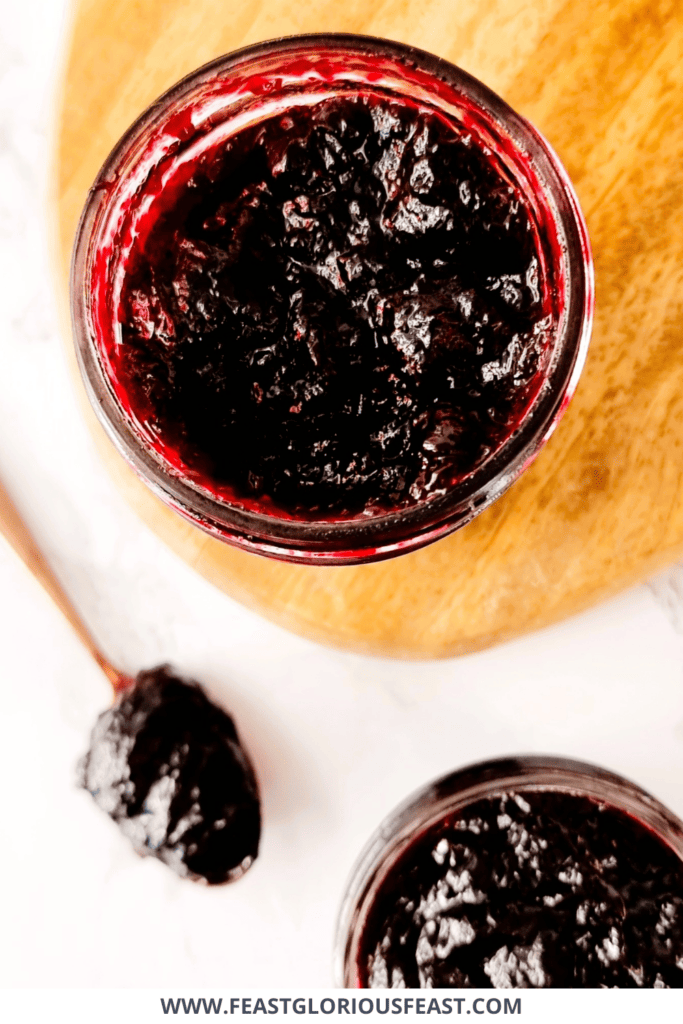







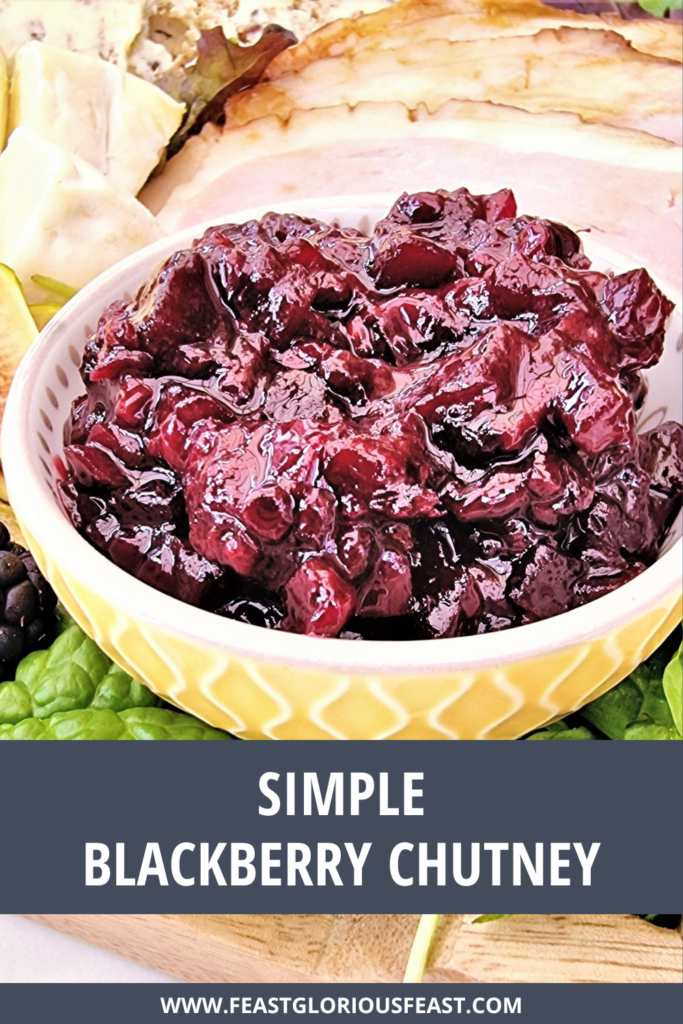
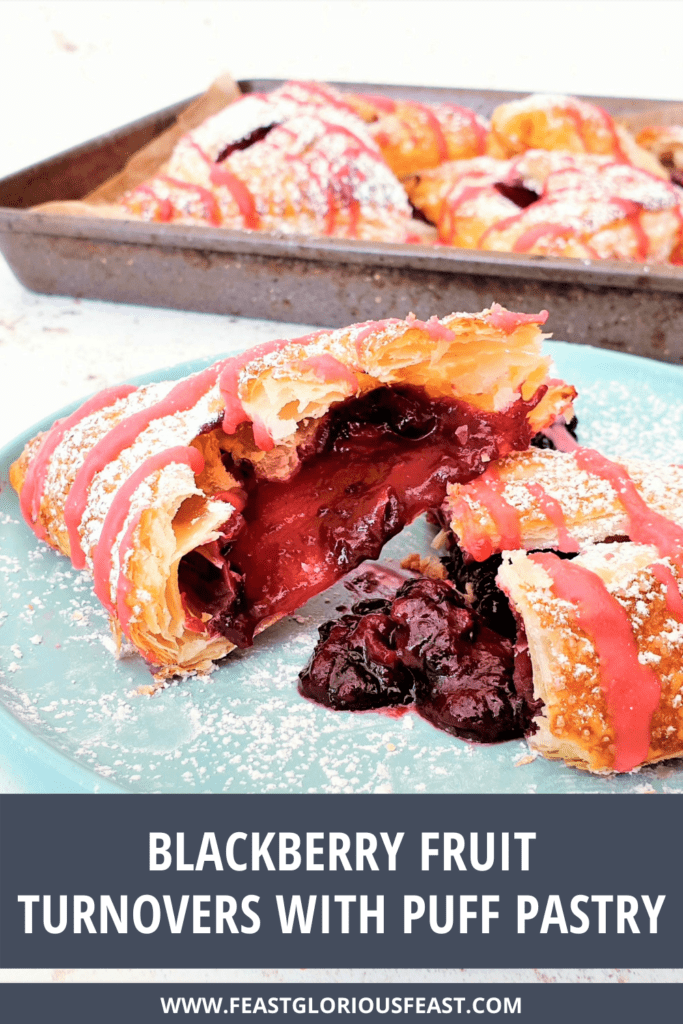
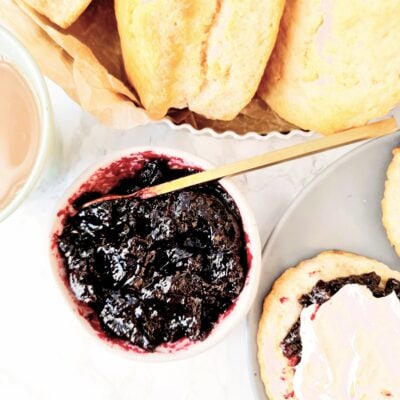















Allie says
Can I use frozen berries picked from our garden? And how much bourbon would you suggest be added and at what stage? Thanks
Chloe says
You can absolutely use your frozen home grown berries! The amount of bourbon you want to add is really up to you and how strong you want the flavour to me. You could add a very good glug as the fruit starts to cook down. This will mellow the flavour. For a more pronounced bourbon flavour, you can stir a tablespoon or so in right near the very end of the cooking process. I wouldn’t add too much at this stage as you don’t want to overpower the fruit and you don’t want to water the jam down with too much extra liquid.
Cat says
I made this a while ago with berries I picked. Not only was it delicious but it made me feel very accomplished to have not only picked the berries but made a delicious jam too!
Shirley says
So delicious and I love how long it lasts. Blackberry jam through the winter for the win.
Dave says
I’m absolutely with you on blackberry seeds, they are horrible. I made your jam and am thrilled at how easy it was and it tastes amazing.
Lesley says
Great small batch jam recipe, ideal for a small picking of brambles.